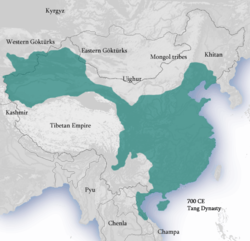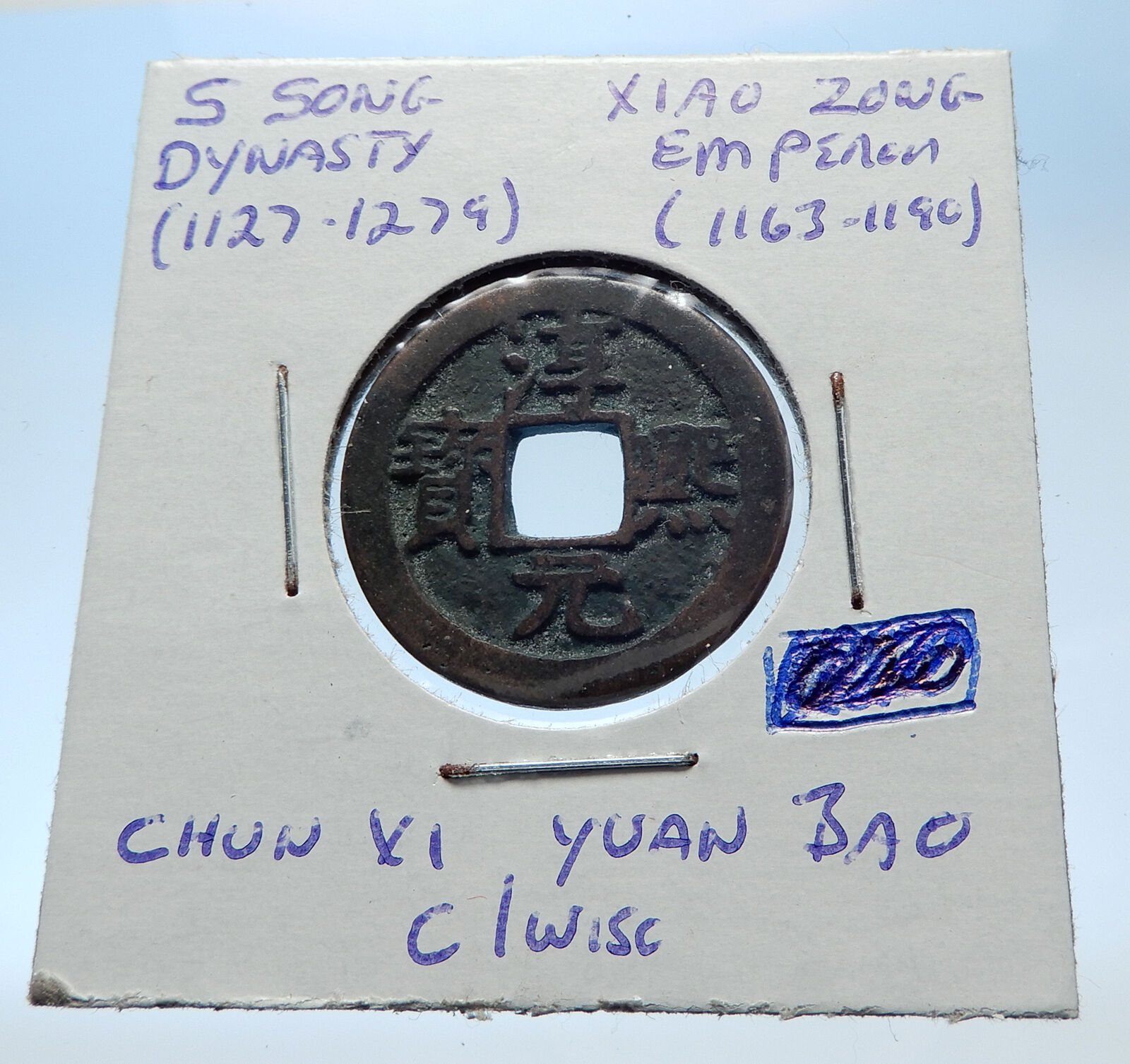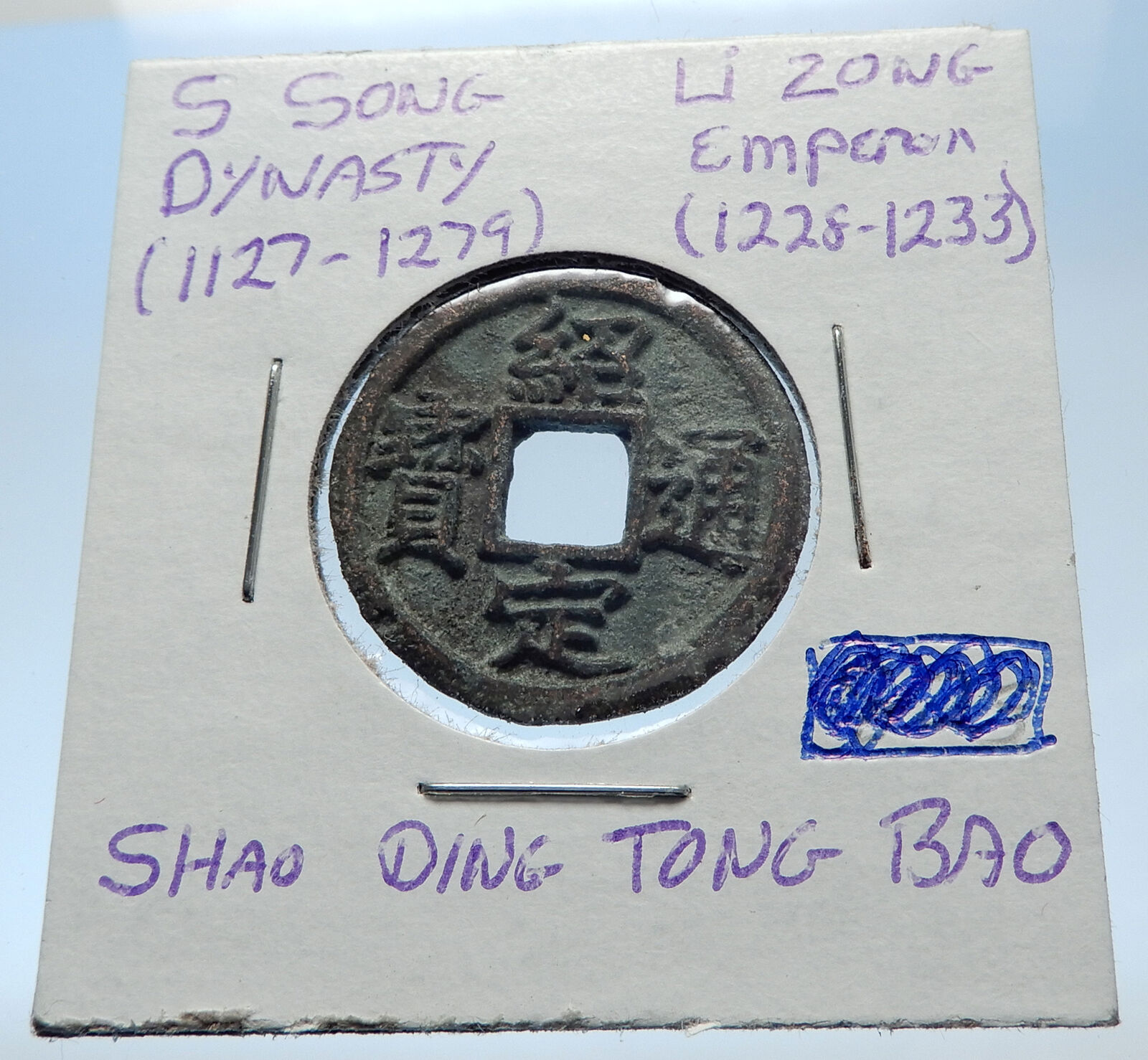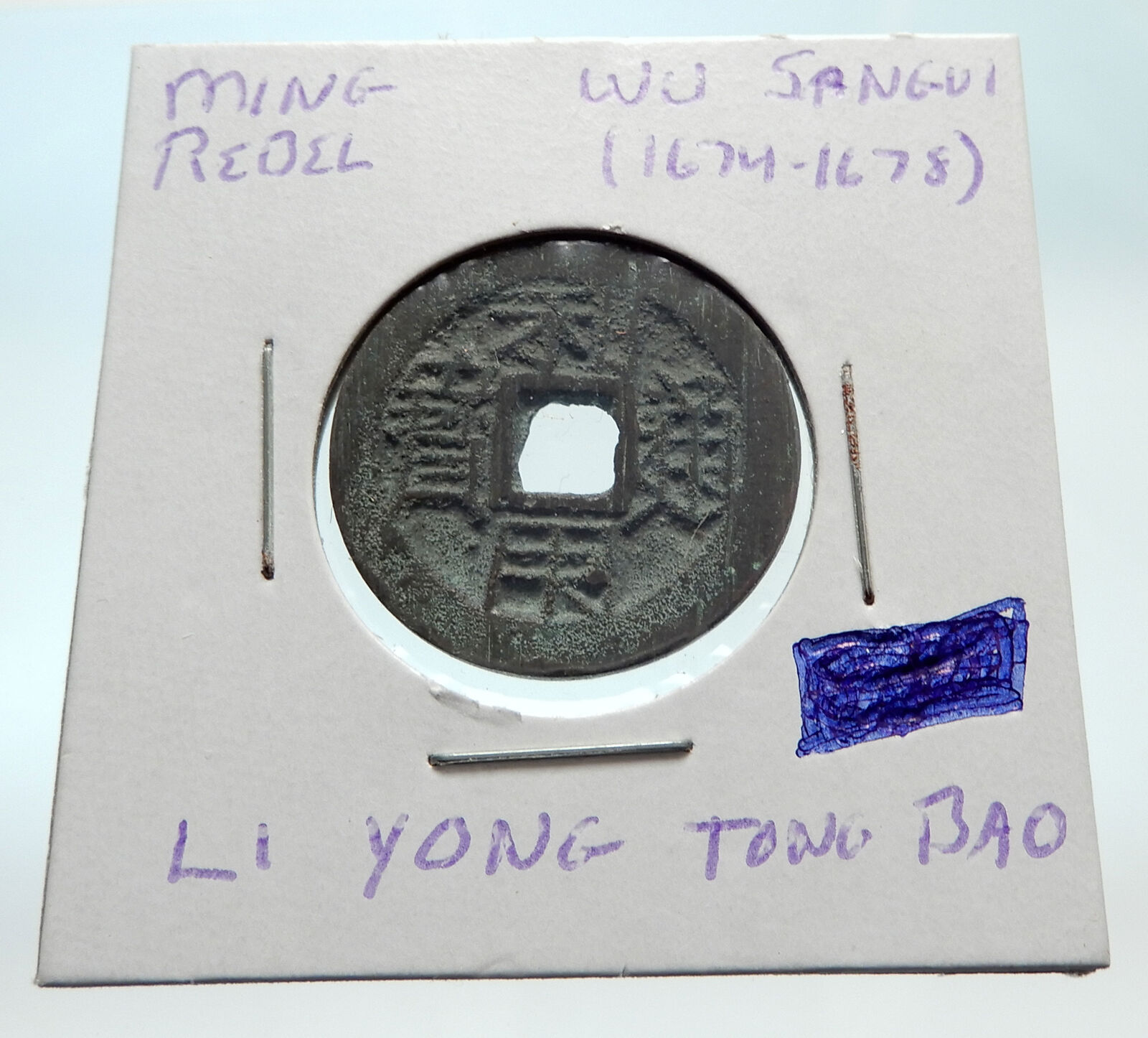|
China – Tang Dynasty (618-907 A.D.)
Su Zong – Emperor: 756-762 AD
Bronze
Qian Yuan Zong Bao Cash
25mm, Struck 756-765
AD
Reference: H# 14.114
開元通寶, Four Chinese characters, square hole within.
You are bidding on the exact item pictured, provided with a Certificate of Authenticity and Lifetime Guarantee of Authenticity.
 The The
Tang dynasty (Chinese: 唐朝) or the Tang
Empire was an imperial dynasty of China,
preceded by the Sui dynasty and followed by the
Five Dynasties and Ten Kingdoms period.
Historians generally regard the Tang as a high
point in Chinese civilization, and a golden age
of cosmopolitan culture. Tang territory,
acquired through the military campaigns of its
early rulers, rivaled that of the Han dynasty.
The Tang capital at Chang’an (present-day Xi’an)
was the most populous city in the world in its
day.
The Lǐ family (李) founded the
dynasty, seizing power during the decline and
collapse of the Sui Empire. The dynasty was
briefly interrupted when Empress Wu Zetian
seized the throne, proclaiming the Second Zhou
dynasty (690-705) and becoming the only Chinese
empress regnant. In two censuses of the 7th and
8th centuries, the Tang records estimated the
population by number of registered households at
about 50 million people. Yet, even when the
central government was breaking down and unable
to compile an accurate census of the population
in the 9th century, it is estimated that the
population had grown by then to about 80 million
people.[9][10][b] With its large
population base, the dynasty was able to raise
professional and conscripted armies of hundreds
of thousands of troops to contend with nomadic
powers in dominating Inner Asia and the
lucrative trade-routes along the Silk Road.
Various kingdoms and states paid tribute to the
Tang court, while the Tang also conquered or
subdued several regions which it indirectly
controlled through a protectorate system.
Besides political hegemony, the Tang also
exerted a powerful cultural influence over
neighboring East Asian states such as those in
Japan and Korea.
The Tang dynasty was
largely a period of progress and stability in
the first half of the dynasty’s rule, until the
An Lushan Rebellion and the decline of central
authority in the later half of the dynasty. Like
the previous Sui dynasty, the Tang dynasty
maintained a civil-service system by recruiting
scholar-officials through standardized
examinations and recommendations to office. The
rise of regional military governors known as
jiedushi during the 9th century undermined
this civil order. Chinese culture flourished and
further matured during the Tang era; it is
traditionally considered the greatest age for
Chinese poetry. Two of China’s most famous
poets, Li Bai and Du Fu, belonged to this age,
as did many famous painters such as Han Gan,
Zhang Xuan, and Zhou Fang. Scholars of this
period compiled a rich variety of historical
literature, as well as encyclopedias and
geographical works. The adoption of the title
Tängri Qaghan by the Tang Emperor Taizong in
addition to his title as emperor was eastern
Asia’s first “simultaneous kingship”.
Many notable innovations occurred under the
Tang, including the development of woodblock
printing. Buddhism became a major influence in
Chinese culture, with native Chinese sects
gaining prominence. However, in the 840s the
Emperor Wuzong of Tang enacted policies to
persecute Buddhism, which subsequently declined
in influence. Although the dynasty and central
government had gone into decline by the 9th
century, art and culture continued to flourish.
The weakened central government largely withdrew
from managing the economy, but the country’s
mercantile affairs stayed intact and commercial
trade continued to thrive regardless. However,
agrarian rebellions in the latter half of the
9th century resulted in damaging atrocities such
as the Guangzhou massacre of 878-879.
The Kaiyuan Tongbao (開元通寶;
开元通宝; lit. ‘Circulating treasure
from the inauguration of a new epoch’),
sometimes romanised as Kai Yuan Tong Bao
or using the archaic Wade-Giles spelling
K’ai Yuan T’ung Pao, was a Tang dynasty
cash coin that was produced from 621 under the
reign of Emperor Gaozu and remained in
production for most of the Tang dynasty until
907. The Kaiyuan Tongbao was notably the first
cash coin to use the inscription tōng bǎo
(通寶) and an era title as opposed to have an
inscription based on the weight of the coin as
was the case with Ban Liang, Wu Zhu and many
other earlier types of Chinese cash coins. The
Kaiyuan Tongbao’s calligraphy and inscription
inspired subsequent Central Asian, Japanese,
Korean, Ryūkyūan, and Vietnamese cash coins and
became the standard until the last cash coin to
use the inscription “通寶” was cast until the
early 1940s in French Indochina.
After the
fall of the Tang dynasty Kaiyuan Tongbao coins
would continue to be produced by various states
of the Five Dynasties and Ten Kingdoms period.
Under the Tang dynasty the earlier Wu Zhu coins
of the Sui dynasty would remain the standard
currency, but during the fourth year of the Wu
De (武德) period (or 621 of the Gregorian
calendar) Emperor Gaozu decreed that the Kaiyuan
Tongbao coin be cast with a strictly enforced
standard weight of 1⁄10 Liǎng (兩).
Unlike earlier Chinese cash coins which had
their legends based on their weight, the Kaiyuan
Tongbao was notably the first Chinese cash coin
to use the tōng bǎo (通寶) inscription
and simultaneously inspired the yuán bǎo
(元寶) inscription. The reason that the Kaiyuan
Tongbao also inspired the yuán bǎo
legend is because the Chinese people themselves
had trouble figuring out the correct character
order, as the inscription is read in what was
referred to as the “standard order”
(top-bottom-right-left) some people accidentally
read it in the wrong order as they had assumed
that the inscription was read clockwise as
Kaitong Yuanbao (開通元寶), this was also because
rather than having the first two characters
spell out the period title (which was Wu De when
the Kaiyuan Tongbao was introduced), they had a
different inscription. However this mistake in
how the legend was read inspired the Northwest
Chinese rebel Shi Siming to cast his own cash
coins with the inscription Shuntian Yuanbao
(順天元寶, shùn tiān yuán bǎo) cash coins
first issued in Luoyang in 759, this coin
however does have a clockwise inscription.
Another term that was used to denote “the
currency type” in Chinese coin inscriptions was
zhòng bǎo (重寶) which could be translated as
“heavy currency”. The first cash coin to have
this inscription was the Qianyuan Zhongbao
(乾元重寶) which was first produced in the year 759.
The terms yuán bǎo (元寶) and zhòng
bǎo (重寶) which were both established during
a 138 year period of the Tang dynasty would
continue to be used on Chinese coins to the very
end of the Qing dynasty in 1911. While the term
tōng bǎo (通寶) was even used longer with the
last Chinese cash coin, the Minguo Tongbao
(民國通寶) being produced in Dongchuan, Yunnan
during the early Republic of China period.
Another important difference with the
inscription of the Kaiyuan Tongbao compared to
earlier Chinese cash coins was that it was not
written in seal script but rather in the more
plain calligraphic clerical script. The Emperor
ask one of China’s most well-known
calligraphers, Ouyang Xun to write down the
legend of the cash coin. This was also the first
time in Chinese history that a famous
calligrapher wrote the characters for a Chinese
cash coin. Minting and copper extraction were
centrally controlled, and private casting was
punishable by death. For the first time we find
regulations giving the prescribed coinage alloy:
83% copper, 15% lead, and 2% tin. Previously the
percentages used seem to have been on an ad hoc
basis. Actual analyses show rather less copper
than this.
At first, mints were set up in
Luoyang in Henan, and also in Peking, Chengdu,
Bingzhou (Taiyuan in Shanxi), and then Guilin in
Guangxi. Minting rights were also granted to
some princes and officials. By 660,
deterioration of the coinage due to forgery had
become a problem. The regulations were
reaffirmed in 718, and forgeries suppressed. In
737, the first commissioner with overall
responsibility for casting was appointed. 1
furnace that produced 3.3 million Kaiyuan
Tongbao coins a year during the Tian Bao period
between 713 and 756 would need 21220 jin of
copper, 3709 jin of tin, and 540 jin per
regulation of lead and had an average waste of
23,5 %. The Kaiyuan Tongbao cash coins produced
during the Tian Bao period had an officially set
copper alloy however some Kaiyuan coins from
this period were blue or white it’s likely that
other alloys were also used. In 739, ten mints
were recorded, with a total of 89 furnaces
casting some 327,000 strings of cash a year. 123
liang of metal were needed to produce a
string of coins weighing 100 liang. In
the late 740s, skilled artisans were employed
for casting, rather than conscripted peasants.
Despite these measures, the coinage continued to
deteriorate. In 808, a ban on hoarding coins was
proclaimed. This was repeated in 817. Regardless
of the rank of a person, they could not hold
more than 5,000 strings of cash. Cash balances
exceeding this amount had to be expended within
two months to purchase goods. This was an
attempt to compensate for the lack of cash in
circulation. By 834, mint output had fallen to
100,000 strings a year, mainly due to the
shortage of copper. Forgeries using lead and tin
alloys were produced.
Due to the fact that
this continued to be produced for two centuries
by various mints all over China there are
several hundred varieties of the Kaiyuan Tongbao
that can be distinguished from each other due to
slight differences.
The Kaiyuan Tongbao
cash coins that were first cast until the height
of the Tang period, early issues can be very
accurately assigned to their time of casting and
archeological evidence from Tang era tombs
indeed prove that the first stroke of the
character “元” are shorter than later versions,
for this reason these coins are referred to as
“short one yuan” (短一元, duǎn yī yuán)
versions. A lesser quantity of these early
Kaiyuan Tongbao cash coins are made from what
the Chinese call “white copper” (白銅, bái
tóng) and are subsequently referred to as
“White Copper/Baitong Kaiyuan Tongbao coins”
(白銅開元通寶, báitóng kāiyuán tōng bǎo)
today, however during the Tang dynasty itself
they were given the nickname “pure coins” (青錢,
qīng qián) which also became the basis for
the nickname (外號) of “pure coin scholar” (青錢學士,
qīng qián xué shì) which was given to
Emperor Gaozong as his writings were said to
resemble the coins.
There also exist
Kaiyuan Tongbao cash coins which are
differentiated by their second horizontal
stroke, other than the first variant these
others quite rare. The following versions of the
Kaiyuan Tongbao coin can be distinguished by the
“元” character’s second horizontal stroke (or
“shoulder”):
Kaiyuan Tongbao cash coins
also commonly have differentiating features on
their reverse, these can include crescents which
according to legend happened when either Empress
Zhangsun or Empress Taimu or in some versions of
the story Yang Guifei pressed her fingernail
into a specimen Kaiyuan Tongbao coin made from
wax. Other sources claim that the crescents were
added due to foreign influence. Today it is
widely believed that these crescents were marks
of quality used by various mints.
Other
than crescents, there were several Kaiyuan
Tongbao coins with other reverse decorations,
these include:
Early Kaiyuan Tongbao coins
are easily identified due to their deeply cut
characters that never touch the rim of the coin,
these are called “separate from the rim” Kaiyuan
Tongbao coins (simplified Chinese: 隔轮開元通宝;
traditional Chinese: 隔輪開元通寶; pinyin: gélún
kāiyuán tōng bǎo), while the reverse of
these coins tend to have uniform and clear rims.
Later variants of the Kaiyuan Tongbao often have
excess metal between the strokes of the Hanzi
characters and even later variants have
characters with strokes so long that they touch
the rim, meanwhile the rims on the reverse side
of these Kaiyuan Tongbao coins tend to be
irregular and relatively flat.
|





 The
The 




